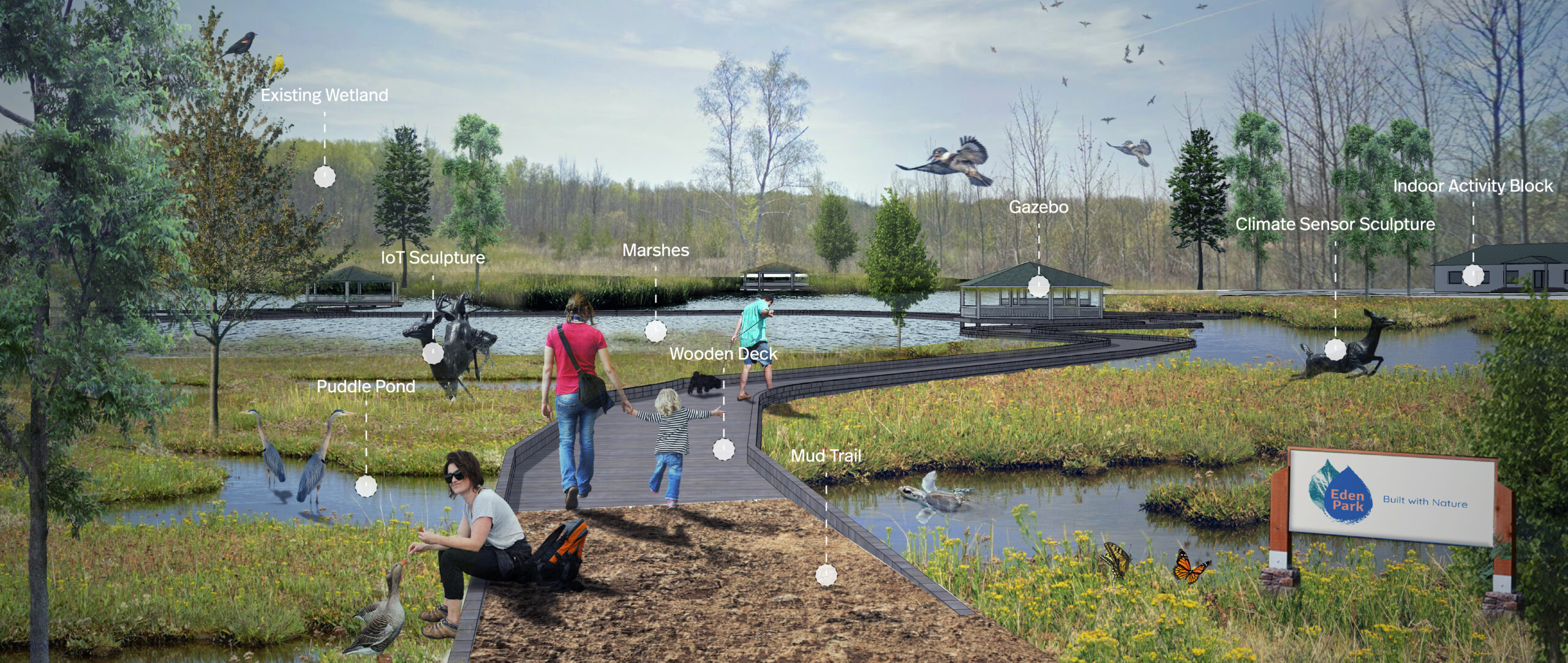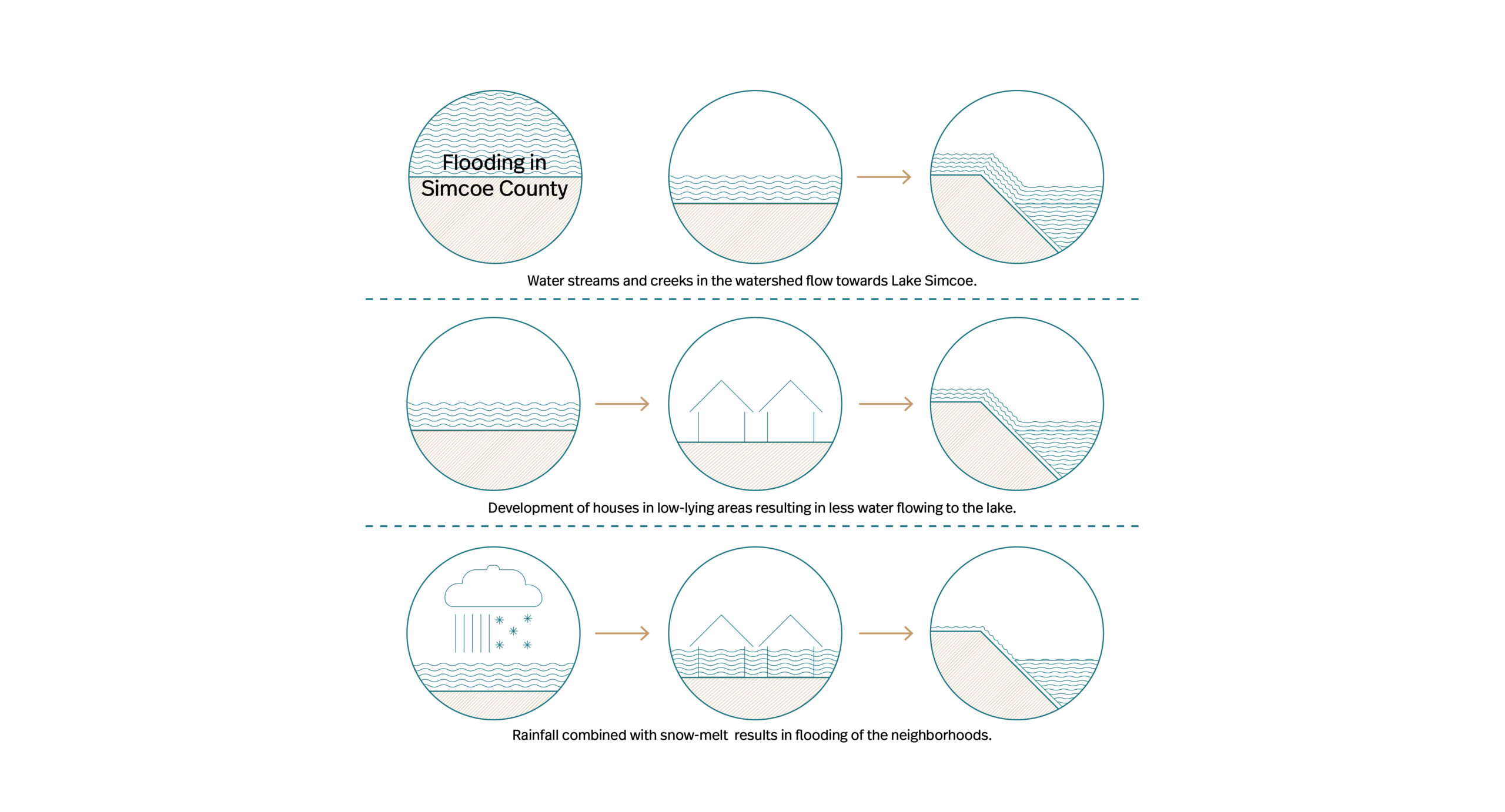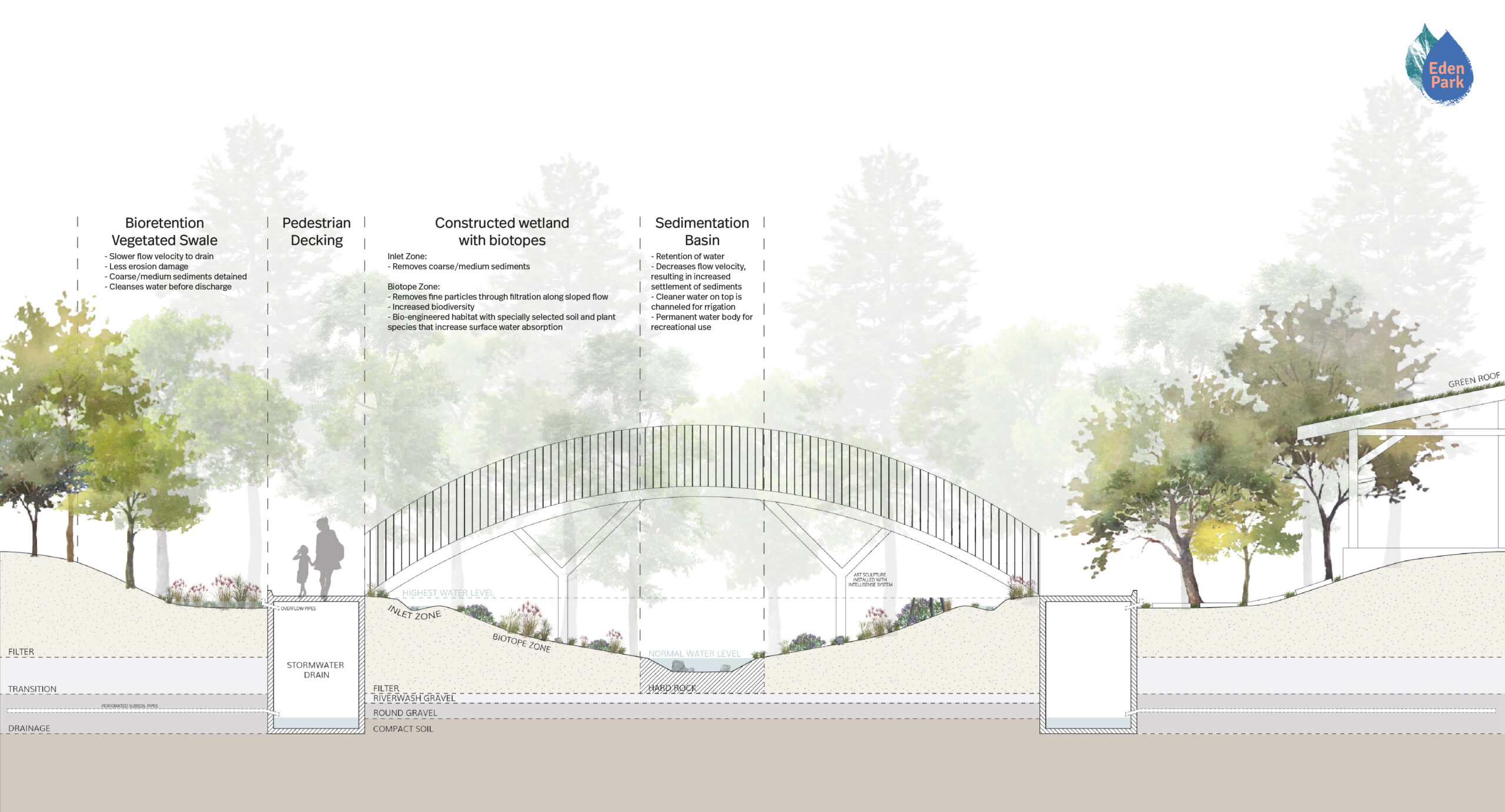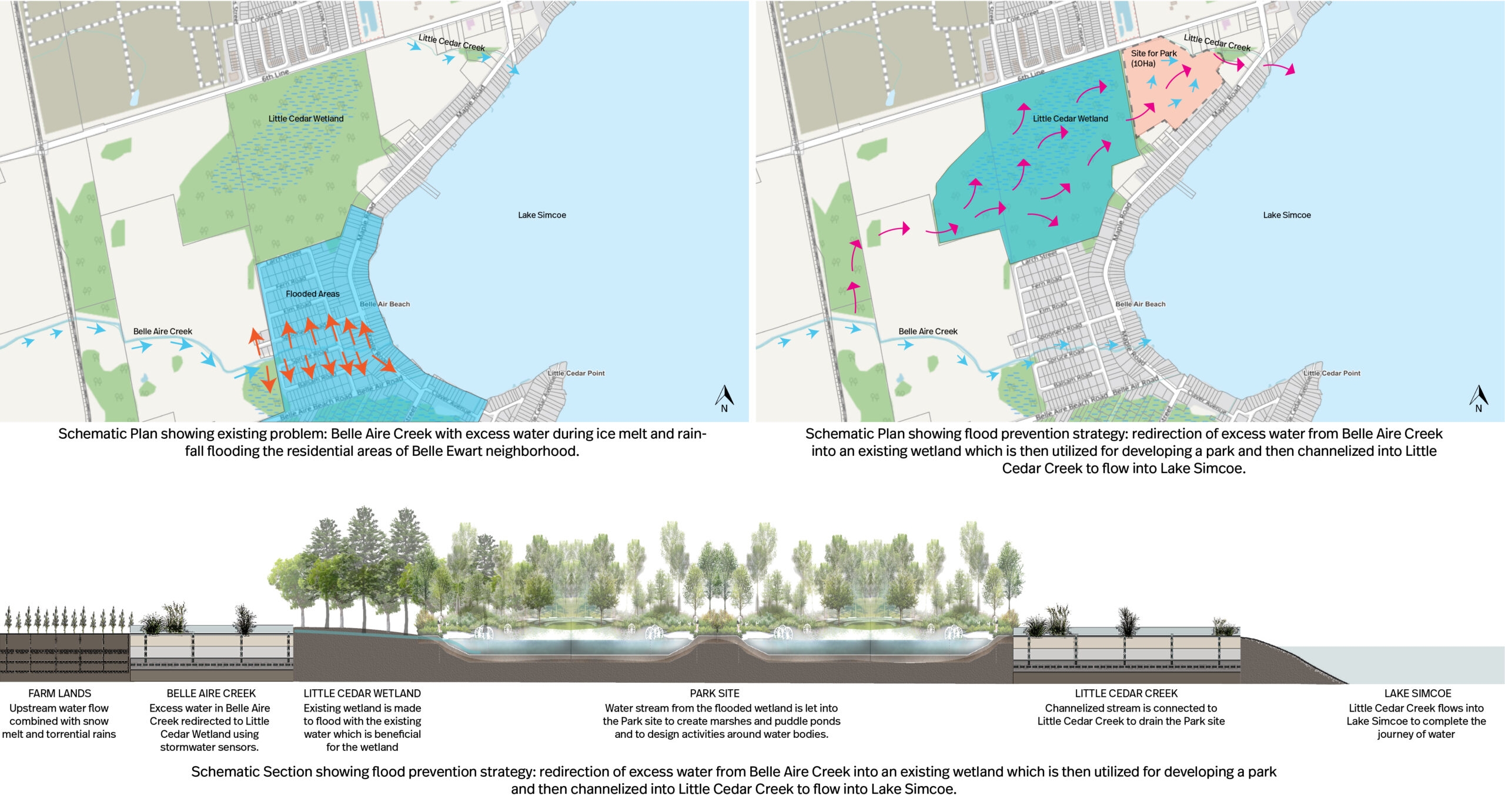Project Description
About the County of Simcoe
Simcoe County, located just north of the Greater Toronto Area, stretches from the shores of Lake Simcoe on the east to Georgian Bay in the west. The county covers 4,860 km2 and supports approximately 300,000 residents. Simcoe’s economy is based on agriculture, natural resource extraction and tourism.
Flooding in Simcoe
limate change has had a significant effect on Lake Simcoe’s watershed over the past decade. While flooding used to occur mostly during spring, the effects of climate change are evident now as it floods even in the winter months. The main causes for the floods are development in low-lying areas, surface runoff and the saturation of municipal drains during weather events. One of the most adversely affected areas in the county is the Belle Ewart area in the municipality of Innisfil, located in a low-lying zone along the south-western shore of Lake Simcoe. Even though the municipality takes several measures for recovery and relief every year, the residents need an effective solution to their problems.
IwB Design Proposals
Students in the IwB 2019-2020 cohort expanded on the County of Simcoe’s Smart Cities proposal from the International and Production Charrette using the ESC Framework. An adjusted vision, mission and project scope were created for the design proposals.
Vision: To harness the potential of natural resources and systems to reduce flooding in watershed areas, increase safety and improve health conditions in the County of Simcoe.
Mission: To develop a sustainable pilot project by using green infrastructure and technology that reduces flooding in the Lake Simcoe watershed area, while engaging stakeholders in promoting the benefits of natural systems.
Proposed Site/Project Scope: This design proposal will focus on the Belle Ewart area in the municipality of Innisfil, located in a low-lying zone along the south-western shore of Lake Simcoe.
Solution
The Eden Park project explores how taking a nature-oriented approach can lead to sustainable solutions. It aims to re-establish the balance between nature and human activities through elements such as walking trails, marshes, puddle ponds, community gathering spaces and farmers’ markets. Eden Park is planned as a low-impact development. Porous and sustainable materials will be used to develop the built structures of the project and all existing tree covers will be retained. A key component of Eden Park is to create a sense of safety and well-being through therapeutic healing, meditation and yoga facilities. Sculptures equipped with IoT sensors will collect microclimate data, while sound boxes spread throughout the park will record the sounds of the park and transmit a live audio stream to mobile devices.
Wetlands are an important element of a watershed as they can reduce flooding by holding water, filter harmful elements in the water, and provide habitat to diverse species of wildlife. Flooding issues in the Belle Ewart neighbourhood of Innisfil can be mitigated with the help of smart technology combined with green infrastructure. To complete the flow of water, the excess water will be channeled into the Little Cedar Creek which flows into Lake Simcoe.
Process
This section will show how the ESC Framework was tested using the Simcoe Design Proposal. It showcases how the goals of each step of the framework was met by Eden Park establishing it as an Ethical Smart City solution to address the needs of the community.
1. KNOW
What is your definition of an Ethical Smart City?
An Ethical Smart City is one which values its natural infrastructure and practices safe and sustainable development by integrating smart technologies with natural systems.
2. PERSONALIZE
What are the needs of your community (including the right challenge to address, the prioritized values of the community and the appropriate technology to address it)?
Challenges
- Simcoe County’s flooding challenge has a major impact on the health and well-being of its community.
- Climate change and existing infrastructure intensify the impacts of flooding in the area.
Values
- Safety: flooding impacts the overall well-being of the community in Simcoe. Chronic flooding leads to pest infestation and damages to public and private buildings and infrastructure.
- Sustainability: mitigating the impacts of climate change, including flooding, while promoting sustainable and holistic practices that promote health and well-being.
Technology
- IoT and Sensors: can collect microclimate data that can be used to understand the impacts of climate change.
- Green Infrastructure: allows nature to be integrated with the existing habitat.
3. STRATEGIZE
What are the community goals that the solution to the challenge should embody?
- To balance the needs of the community with the needs of the environment.
- To use existing urban and natural infrastructure to create sustainable solutions.
- To engage various stakeholders, who are impacted by flooding in Simcoe County.
- To improve the overall health and well-being of the community, while connecting them to nature.
- To help limit the amount of public and private damage caused by flooding.
- To promote a sense of community.
4. DESIGN
What is the design solution to address the challenge and how does it uphold the ethical values?
The Eden Park project explores the balance between nature and humanity. The project entails taking advantage of existing wetlands in Simcoe county by redirecting excess water. This excess water, from areas like Belle Ewart, will be used to create awareness of wetland ecosystems and elevate the health quotient of the community. This will be done by designing the park as an extension of the wetland systems – creating marshes, puddle ponds, and habitats for flora and fauna. The community can experience wetlands systems, by indulging in the various activities available in the park or simply exploring the trails. Eden Park helps educate the population about flooding prevention and instills a sense of safety in the community.
The proposed park will connect the community closer to the wetland ecosystem to help foster an appreciation of nature and the wetlands. Eden Park’s facilities and programming is meant to promote healthy lifestyles and well-being through therapeutic services, walking trails and community gathering spaces. Smart sensors and IoT systems weave the various elements together in a co-existing natural and technological environment.
5. ADAPT
What is the implementation plan of the solution?
The Implementation Plan has a few components. The pilot, the expansion, and the final phase.
The initial phase of Eden Park focuses on the Belle Ewart neighbourhood of Innisfil and helps establish the importance of natural systems in the watersheds of Simcoe County. With a budget of $10 million, Eden Park will include a series of programs and events around therapeutic healing, meditation and yoga facilities and nature trails.
In the expansion phase, Eden Park will look to other neighbourhoods impacted by flooding in Simcoe County. The number of holistic programs that balance nature and humans will increase across the County. Partnerships with local organizations that have climate change mandates will create and foster social connections between the community. Data and information gathered from existing green infrastructure will help determine the number of programs to be deployed.
The final phase of Eden Park will involve partnering with other municipalities across Ontario and Canada committed to tackling floods. This will provide an opportunity for the County of Simcoe to share their learnings with other communities and strengthen knowledge dissemination to create well-balanced communities across Canada. The final phase of Eden Park will also expand programming to incorporate ideas and proposals from the community that not only addresses flooding, but also highlights the importance of natural systems in the watersheds of Simcoe County.








